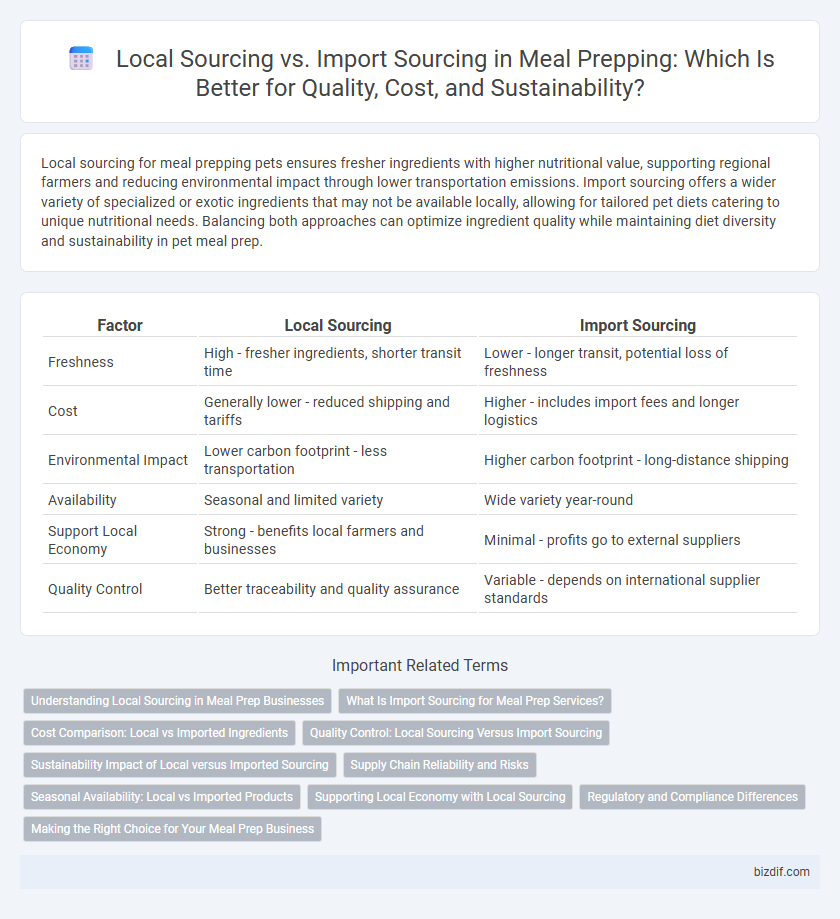Local sourcing for meal prepping pets ensures fresher ingredients with higher nutritional value, supporting regional farmers and reducing environmental impact through lower transportation emissions. Import sourcing offers a wider variety of specialized or exotic ingredients that may not be available locally, allowing for tailored pet diets catering to unique nutritional needs. Balancing both approaches can optimize ingredient quality while maintaining diet diversity and sustainability in pet meal prep.
Table of Comparison
| Factor | Local Sourcing | Import Sourcing |
|---|---|---|
| Freshness | High - fresher ingredients, shorter transit time | Lower - longer transit, potential loss of freshness |
| Cost | Generally lower - reduced shipping and tariffs | Higher - includes import fees and longer logistics |
| Environmental Impact | Lower carbon footprint - less transportation | Higher carbon footprint - long-distance shipping |
| Availability | Seasonal and limited variety | Wide variety year-round |
| Support Local Economy | Strong - benefits local farmers and businesses | Minimal - profits go to external suppliers |
| Quality Control | Better traceability and quality assurance | Variable - depends on international supplier standards |
Understanding Local Sourcing in Meal Prep Businesses
Local sourcing in meal prep businesses emphasizes using fresh, seasonal ingredients from nearby farms and suppliers, ensuring higher nutritional value and reducing carbon footprints. It enhances food quality, supports local economies, and offers traceability, which builds customer trust and meets sustainability goals. Meal prep companies relying on local sourcing often benefit from shorter supply chains, leading to fresher meals and lower transportation costs.
What Is Import Sourcing for Meal Prep Services?
Import sourcing for meal prep services involves procuring ingredients from international suppliers to access diverse or specialty food products not available locally. This approach can introduce unique flavors and cater to niche dietary preferences, though it may result in longer delivery times and higher transportation costs. Meal prep companies weigh these factors against the benefits of variety and exclusivity when selecting import sourcing strategies.
Cost Comparison: Local vs Imported Ingredients
Local sourcing often reduces costs by minimizing transportation fees, tariffs, and middlemen expenses, resulting in fresher ingredients at competitive prices for meal prepping. Imported ingredients may have higher upfront costs due to shipping, import duties, and longer supply chains, yet they can offer unique flavors not available locally. Evaluating meal prep budgets requires balancing these cost factors with ingredient quality and availability to optimize overall value.
Quality Control: Local Sourcing Versus Import Sourcing
Local sourcing enhances quality control by allowing direct inspection of produce, ensuring freshness and reducing the risk of contamination compared to import sourcing. Import sourcing often involves longer supply chains, increasing variability in product quality and complicating quality assurance processes. Maintaining stringent quality control standards is more feasible with local suppliers due to proximity and clearer communication channels.
Sustainability Impact of Local versus Imported Sourcing
Local sourcing in meal prepping significantly reduces carbon emissions by minimizing transportation distances, promoting fresher ingredients and supporting regional agriculture. Imported sourcing often involves extensive shipping and refrigeration, increasing the environmental footprint and contributing to higher greenhouse gas emissions. Prioritizing local, seasonal produce enhances sustainability by conserving energy and reducing reliance on global supply chains.
Supply Chain Reliability and Risks
Local sourcing in meal prepping ensures higher supply chain reliability by reducing transportation delays and minimizing exposure to global disruptions such as tariffs or pandemics. Import sourcing often introduces risks like fluctuating customs regulations, longer lead times, and vulnerability to international shipping bottlenecks. Meal prep businesses focusing on consistent ingredient availability benefit from prioritizing local suppliers to maintain stable operations and quality control.
Seasonal Availability: Local vs Imported Products
Seasonal availability significantly impacts meal prepping choices, with locally sourced products offering peak freshness and nutrient density due to harvesting during their natural growing seasons. Imported products can fill gaps in availability, providing a wider variety of ingredients year-round but often at the cost of extended transit times that may reduce quality. Prioritizing local, seasonal produce enhances flavor and supports sustainable practices, while imported options ensure menu diversity when local supply is limited.
Supporting Local Economy with Local Sourcing
Local sourcing in meal prepping enhances community sustainability by prioritizing fresh, seasonal ingredients directly from nearby farms and producers. This approach reduces carbon footprint due to shorter transportation distances and strengthens the local economy by generating income and jobs within the region. Consumers benefit from higher-quality, nutrient-rich foods while contributing to the resilience of local agricultural systems.
Regulatory and Compliance Differences
Local sourcing for meal prepping ensures adherence to domestic food safety regulations and labeling standards, which often results in faster compliance verification and reduced risk of import delays. Import sourcing requires navigating complex international trade laws, customs inspections, and varying compliance certifications that differ between countries, potentially increasing the likelihood of non-compliance and shipment holds. Understanding regional regulatory frameworks and maintaining updated documentation is crucial for seamless integration of either local or imported ingredients in meal prep operations.
Making the Right Choice for Your Meal Prep Business
Choosing between local sourcing and import sourcing significantly impacts your meal prep business's freshness, cost, and sustainability. Local sourcing ensures fresher ingredients, supports local farmers, and reduces carbon footprint, while import sourcing offers a wider variety of unique ingredients and potential cost savings on bulk products. Evaluating factors such as seasonal availability, supplier reliability, and customer preferences helps optimize ingredient quality and profit margins in your meal prep operations.
Local Sourcing vs Import Sourcing Infographic

 bizdif.com
bizdif.com